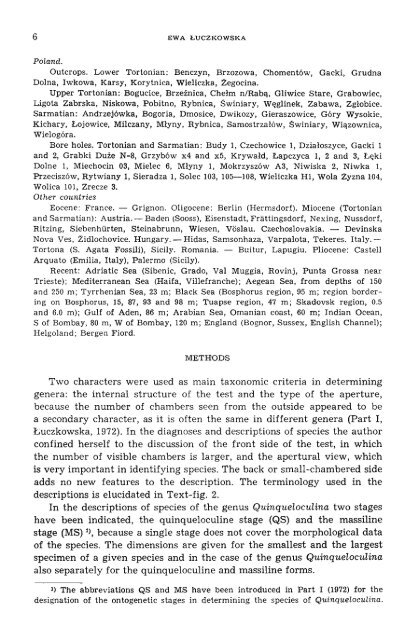MILIOLIDAE - Acta Palaeontologica Polonica
MILIOLIDAE - Acta Palaeontologica Polonica
MILIOLIDAE - Acta Palaeontologica Polonica
You also want an ePaper? Increase the reach of your titles
YUMPU automatically turns print PDFs into web optimized ePapers that Google loves.
6 EWA LUCZKOWSKA<br />
Poland.<br />
Outcrops. Lower Tortonian: Benczyn, Brzozowa, Choment6w, Gacki, Grudna<br />
Dolna, Iwkowa, Karsy, Korytnica, Wieliczka, Zegocina.<br />
Upper Tortonian: Bogucice, Brzeznica, Chelm n/RabCl, Gliwice Stare, Grabowiec,<br />
Ligota Zabrska, Niskowa, Pobitno, Rybnica, Swiniary, WE:glinek, Zabawa, Zglobice.<br />
Sarmatian: Andrzej6wka, Bogoria, Dmosice, Dwikozy, Gieraszowice, G6ry Wysokie,<br />
Kichary, Lojowice, Milczany, Mlyny, Rybnica, Samostrza16w, Swiniary, WiClzownica,<br />
Wielog6ra.<br />
Bore holes. Tortonian and Sarmatian: Budy 1, Czechowice 1, Dzialoszyce, Gacki 1<br />
and 2, Grabki Duze N-8, Grzyb6w x4 and x5, Krywald, Lapczyca 1, 2 and 3, LE:ki<br />
Dolne 1, Miechocin 03, Mielec 6, Mlyny 1, Mokrzysz6w A3, Niwiska 2, Niwka 1,<br />
Przecisz6w, Rytwiany 1, Sieradza 1, Solec 103, 105-108, Wieliczka HI, Wola Zyzna 104,<br />
Wolica 101, Zrecze 3.<br />
Other countries<br />
Eocene: France. - Grignon. Oligocene: Berlin (Hermsdorf). Miocene (Tortonian<br />
and Sarmatian): Austria. - Baden (Sooss), Eisenstadt, Frattingsdorf, Nexing, Nussdorf,<br />
Ritzing, Siebenhiirten, Steinabrunn, Wiesen, Voslau. Czechoslovakia. - Devinska<br />
Nova Ves, Zidlochovice. Hungary. - Hidas, Samsonhaza, Varpalota, Tekeres. Italy.<br />
Tortona (S. Agata Fossili), Sicily. Romania. - Buitur, Lapugiu. Pliocene: Castell<br />
Arquato (Emilia, Italy), Palermo (Sicily).<br />
Recent: Adriatic Sea (Sibenic, Grado, Val Muggia, Rovinj, Punta Grossa near<br />
Trieste); Mediterranean Sea (Haifa, Villefranche); Aegean Sea, from depths of 150<br />
and 250 m; Tyrrhenian Sea, 23 m; Black Sea (Bosphorus region, 95 m; region bordering<br />
on Bosphorus, 15, 87, 93 and 98 m; Tuapse region, 47 m; Skadovsk region, 0.5<br />
and 6.0 m); Gulf of Aden, 86 m; Arabian Sea, Omanian coast, 60 m; Indian Ocean,<br />
S of Bombay, 80 m, W of Bombay, 120 m; England (Bognor, Sussex, English Channel);<br />
Helgoland; Bergen Fiord.<br />
METHODS<br />
Two characters were used as main taxonomic criteria in determining<br />
genera: the internal structure of the test and the type of the aperture,<br />
because the number of chambers seen from the outside appeared to be<br />
a secondary character, as it is often the same in different genera (Part I,<br />
Luczkowska, 1972). In the diagnoses and descriptions of species the author<br />
confined herself to the discussion of the front side of the test, in which<br />
the number of visible chambers is larger, and the apertural view, which<br />
is very important in identifying species. The back or small-chambered side<br />
adds no new features to the description. The terminology used in the<br />
descriptions is elucidated in Text-fig. 2.<br />
In the descriptions of species of the genus Quinqueloculina two stages<br />
have been indicated, the quinqueloculine stage (QS) and the massiline<br />
stage (MS) 1), because a single stage does not cover the morphological data<br />
of the species. The dimensions are given for the smallest and the largest<br />
specimen of a given species and in the case of the genus Quinqueloculina<br />
also separately for the quinqueloculine and massiline forms.<br />
1) The abbreviations QS and MS have been introduced in Part I (1972) for the<br />
designation of the ontogenetic stages in determining the species of Quinqueloculina.
















